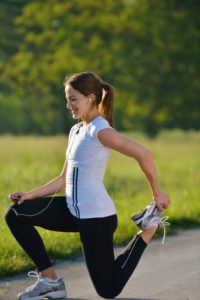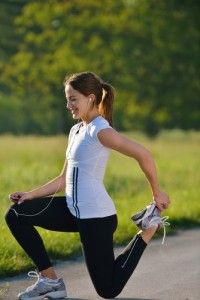
Post by Amy Slater. Amy is a Certified Personal Trainer and Wellness Instructor at Rex Wellness Center of Raleigh.
In order to move efficiently, muscles must be able to slide and glide against one another. The more you move, the more efficiently your muscles are able to move. When you go for long periods without movement, your muscles become less efficient. One of the reasons for this is that the muscle tissue actually grows fuzz that prevents them from sliding and gliding against one another. The longer you go without movement the more fuzz that you grow. The more fuzz you accumulate the more difficult it is to move. Thus, the cycle of a little less motion, a little less motion, and a little less motion begins and your range of motion begins to decrease.
The fuzz that grows between the sliding surfaces of muscles can grow overnight, which is why when you wake up in the morning you may feel stiff. This type of fuzz is relieved with some stretching and movement. A month long injury solidifies fuzz and can inhibit motion. This type of fuzz often requires bodywork to manually introduce movement. The build up of fuzz can also occur with aging and limit cycles can develop. These limit cycles cause alterations in the joints and overall body stiffness. Again, bodywork can help relieve the stiffness caused by aging muscles that have become fuzzed over because of lack of movement.

No matter your age, you can reduce the affects of fuzz on your muscles and prevent your body from entering the cycle of reduced range of motion. Some techniques that help reduce the fuzz are stretching before you go to sleep, self-myofascial release with the foam roller, dynamic mobility and massage. When you stretch, you should focus on the foot and ankle, your hips, and your thoracic spine or rib cage area of your back.
Here are a few simple stretches/massage techniques to get you started:
- Foot and ankle: Sit on a chair with one foot resting on your other knee, gently work one finger between each of your toes spreading them apart. Next grasp the top of the foot with one hand and the heel of the foot with your other hand and gently twist them in opposite directions as if you were wringing out a towel.
- Hips: Stand facing a sturdy chair, place one foot up on the chair. Turn your back foot in slightly and keep your knee straight. Bend your front knee until you feel a gently stretch through your back leg hip and groin. Now reach both arms up at overhead as you stretch forward to enhance the stretch. Complete 10-20 per side.
- Thoracic spine: Stand with your back to the wall. With feet parallel, rotate your torso around to the right placing your hands on the wall hold for a count of 5 then rotate to the other side. Complete 5-10 per side.
These are just a few simple stretches to get you started defuzzing your body. You should strive for some sort of consistent movement daily, avoid sitting in one position for long periods of time, and add some mobility to your daily routine. Regular massage can help your body maintain range of motion which allows you to minimize compensations and prevent pain. Schedule a session with one of our licensed massage therapists or certified personal trainers to have a defuzzing program designed specifically for you. Happy movement!

